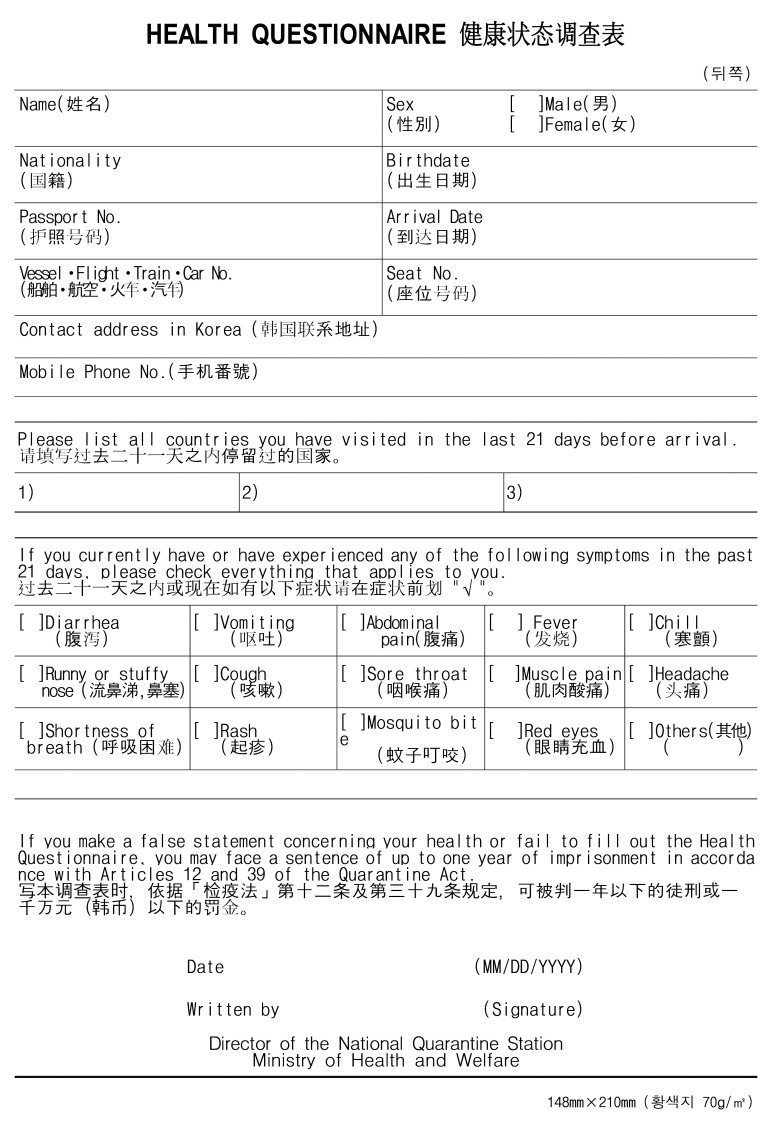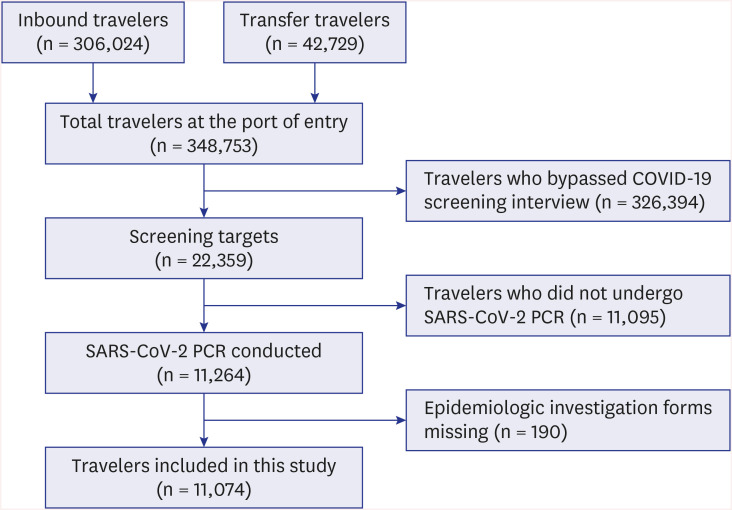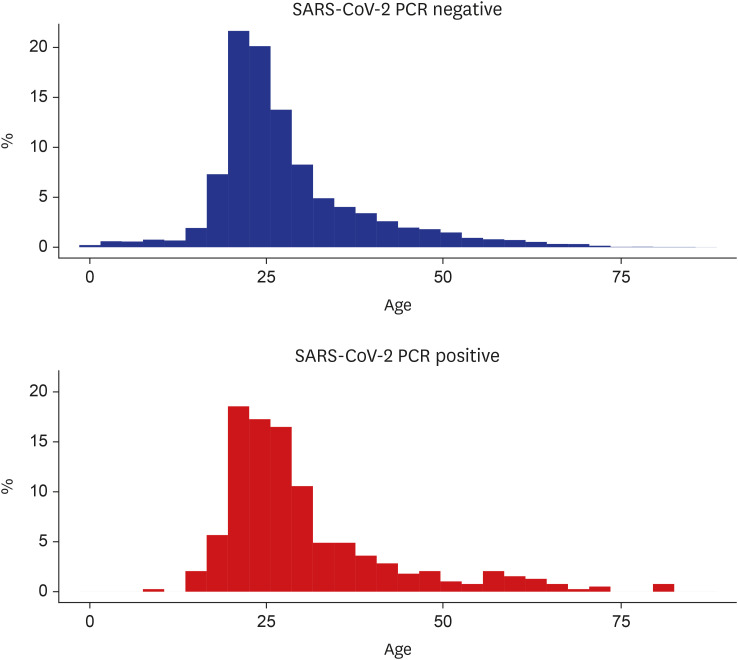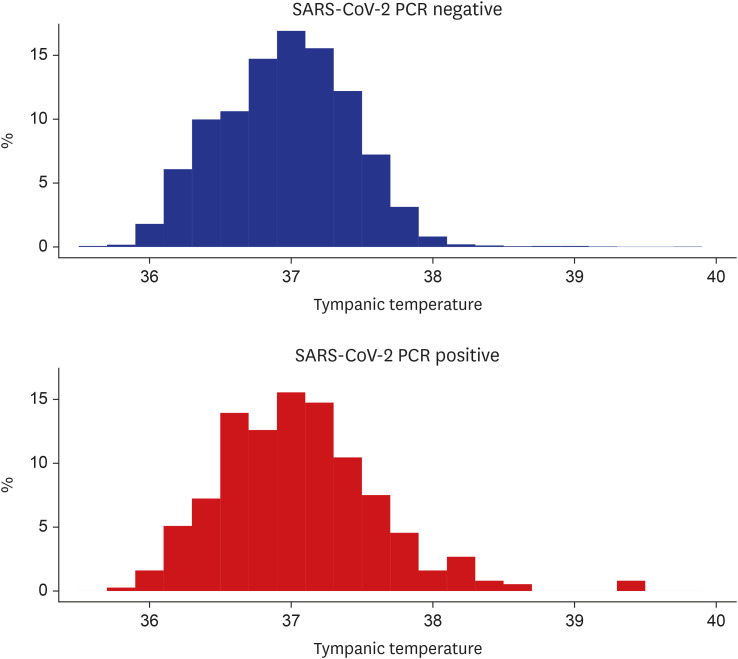J Korean Med Sci.
2021 Jan;36(2):e14. 10.3346/jkms.2021.36.e14.
Symptoms and Characteristics Which Require Attention During COVID-19 Screening at a Port of Entry
- Affiliations
-
- 1Department of Anesthesiology and Pain Medicine, Yangju Armed Forces Hospital, Yangju, Korea
- 2Incheon Airport National Quarantine Station, Incheon, Korea
- 3Department of Preventive Medicine, Wonju College of Medicine, Yonsei University, Wonju, Korea
- KMID: 2510587
- DOI: http://doi.org/10.3346/jkms.2021.36.e14
Abstract
- Background
The quarantine process at a country's port of entry has an important role in preventing an influx of coronavirus disease 2019 (COVID-19) cases from abroad and further minimizing the national healthcare burden of COVID-19. However, there has been little published on the process of COVID-19 screening among travelers entering into a country. Identifying the characteristics of COVID-19 infected travelers could help attenuate the further spread of the disease.
Methods
The authors analyzed epidemiological investigation forms and real-time polymerase chain reaction (PCR) results for severe acute respiratory syndrome coronavirus-2 (SARS-CoV-2) of entrants to Incheon International Airport between March 11 to April 30, 2020. We performed univariate and multivariate logistic regression analysis to determine the odds of positive SARS-CoV-2 result.
Results
A total of 11,074 entrants underwent reverse-transcription PCR for SARS-CoV-2, resulting 388 confirmed cases of COVID-19 infection. COVID-19 had a strong association with the reported loss of smell or taste and association with self-reported fever, chill, cough, and vomiting. If a traveler reported contact with an individual with either respiratory symptoms or confirmed COVID-19 in the last two weeks directly prior to landing, the probability of a positive result was increased.
Conclusion
If overseas travelers experience loss of smell or taste in the two weeks prior to arrival, they may require an immediate examination to rule out COVID-19 at a port of entry. As to measure body temperature upon arrival at a port of entry, it is important to screen for any occurrence of fever within the two weeks prior to travel. Also, information with epidemiological relevance, such as recent contact with an individual suffering from any respiratory symptoms or with confirmed COVID-19, should be included in COVID-19 screening questionnaires for international travelers.
Keyword
Figure
Cited by 1 articles
-
Shortcomings of the Korean Government's Policies to Combat the COVID-19 Pandemic and Suggestions for Improvement
Sang-Hyuk Ma
J Korean Med Sci. 2021;36(21):e156. doi: 10.3346/jkms.2021.36.e156.
Reference
-
1. Kakodkar P, Kaka N, Baig MN. A comprehensive literature review on the clinical presentation, and management of the pandemic coronavirus disease 2019 (COVID-19). Cureus. 2020; 12(4):e7560. PMID: 32269893.
Article2. Worldometer. Coronavirus update. Updated 2020. Accessed December 9, 2020. https://www.worldometers.info/coronavirus/.3. Korea Ministry of Government Legislation. Quarantine act enforcement rules. Updated 2020. Accessed November 14, 2020. https://law.go.kr/%EB%B2%95%EB%A0%B9%EB%B3%84%ED%91%9C%EC%84%9C%EC%8B%9D/(%EA%B2%80%EC%97%AD%EB%B2%95%20%EC%8B%9C%ED%96%89%EA%B7%9C%EC%B9%99,%20%EC%84%9C%EC%8B%9D%209).4. Menni C, Valdes AM, Freidin MB, Sudre CH, Nguyen LH, Drew DA, et al. Real-time tracking of self-reported symptoms to predict potential COVID-19. Nat Med. 2020; 26(7):1037–1040. PMID: 32393804.
Article5. Guan WJ, Ni ZY, Hu Y, Liang WH, Ou CQ, He JX, et al. Clinical characteristics of coronavirus disease 2019 in China. N Engl J Med. 2020; 382(18):1708–1720. PMID: 32109013.6. Chen T, Wu D, Chen H, Yan W, Yang D, Chen G, et al. Clinical characteristics of 113 deceased patients with coronavirus disease 2019: retrospective study. BMJ. 2020; 368:m1091. PMID: 32217556.
Article7. Clemency BM, Varughese R, Scheafer DK, Ludwig B, Welch JV, McCormack RF, et al. Symptom criteria for COVID-19 testing of heath care workers. Acad Emerg Med. 2020; 27(6):469–474. PMID: 32396670.
Article8. Liu R, Han H, Liu F, Lv Z, Wu K, Liu Y, et al. Positive rate of RT-PCR detection of SARS-CoV-2 infection in 4880 cases from one hospital in Wuhan, China, from Jan to Feb 2020. Clin Chim Acta. 2020; 505:172–175. PMID: 32156607.
Article9. Kopel J, Perisetti A, Roghani A, Aziz M, Gajendran M, Goyal H. Racial and gender-based differences in COVID-19. Front Public Health. 2020; 8:418. PMID: 32850607.
Article
- Full Text Links
- Actions
-
Cited
- CITED
-
- Close
- Share
- Similar articles
-
- COVID-19 and Smell Loss
- Post-COVID-19 Syndrome
- An unusual presentation of COVID-19: Acute pancreatitis
- Factors Associated with Severe Outcomes of the Coronavirus Disease 2019 among Elderly Patients in South Korea
- A Case of Aphthous Stomatitis in a Healthy Adult Following COVID-19 Vaccination: Clinical Reasoning





